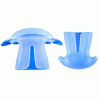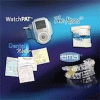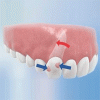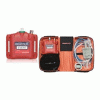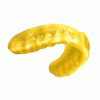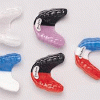You must be signed in to read the rest of this article.
Registration on CDEWorld is free. You may also login to CDEWorld with your DentalAegis.com account.
Cleaning and disinfecting treatment rooms and reprocessing critical instruments, including reusable devices, are infection control and prevention steps clinicians perform behind the scenes, out of the view of the patients who are being treated. These important components in preventing disease transmission are vital facets of safety and health assurance in dentistry. All dental healthcare providers (DHCPs) are responsible for ensuring patient safety by maintaining excellent standards in performing these tasks.
Dental equipment, including power scalers, high-speed rotating handpieces, and air-water syringes, can produce aerosols that contain dental unit water, saliva, blood, dental debris, and other potentially infectious material.1 Among the critical concerns about these aerosols is how far they can travel and contaminate surfaces, and that some of the microorganisms may be antibiotic resistant.2 Improper treatment room cleaning and disinfection, then, is a potential pathway for cross-contamination and possible infection (Table 1).
Treatment Room Cleaning and Disinfection
Treatment rooms are designed to be conducive to effective infection control. The surfaces in them should be uncluttered, items should be put in drawers or cabinets, floors should not be carpeted, and as many processes as possible should be automatic or occur without hand touch, such as with foot-based controls. DHCPs must be able to properly clean and disinfect the treatment room as well as properly discard sharps and single-use items and transport reusable items for cleaning and sterilization.
Contact Surfaces
According to the Centers for Disease Control and Prevention (CDC), surfaces in the treatment room are referred to as "environmental" and can be categorized into clinical contact surfaces and housekeeping surfaces. Clinical contact surfaces are those that may be touched during patient care but cannot be removed and processed between patients. Examples include light handles, radiographic equipment, switches, drawer handles, and faucets. Ideally, these items will have a barrier placed over them that can be removed and discarded to prevent cross-contamination. If they do not, then the surfaces must be cleaned and disinfected with a US Environmental Protection Agency (EPA) low- or intermediate-level registered hospital disinfectant. Low-level disinfectants have a human immunodeficiency virus (HIV) and hepatitis B (HBV) kill claim, while intermediate-level disinfectants also have these claims as well as a tuberculocidal kill claim. If any surface is visibly contaminated, a disinfectant with an intermediate-level claim must be used.3
Chemical disinfectants should be eco-friendly, non-corrosive, water-soluble, non-toxic, and effective against various infectious pathogens. Ideally, they should be inexpensive, and they should also work quickly, have little or no smell, and remain active when used against organic matter. It is also important to read the contact time and kill time on the label; depending on the microorganisms and other factors (eg, humidity and temperature), pathogens can survive on surfaces for extended periods. For example, HBV can remain viable and capable of causing infection on surfaces at room temperature for at least a week in dried blood, and mycobacterium tuberculosis can survive for multiple weeks.4 Adhering to manufacturer instructions is essential for proper decontamination. When cleaning or disinfecting a treatment room, the product must be utilized correctly. For example, the user must know what the contact time is. A product can state a 1-minute kill time, but does that apply for all the microorganisms listed on the label or just most of them? The shortest contact time is typically the longest kill time claim for a product. Another important factor is whether the product is a two-wipe or one-wipe system and whether that system applies to the level of soil for the surface being cleaned (Figure 1).
The Organization for Safety, Asepsis and Prevention (OSAP) recommends classifying clinical surfaces into three categories, as described in Table 2.5
Barriers
When DHCPs have a limited amount of time and numerous responsibilities this can result in inadequate decontamination, especially if a surface has edges or crevices and is difficult to disinfect. This is why the use of barriers to protect clinical surfaces against contamination is a smart practice, especially those surfaces that are high contact or hard to clean.6 Available in many shapes and sizes, barriers are generally made of plastic bags, plastic tubing, or adhesive wraps, and are resistant to liquid penetration and leaking. Non-adhesive barriers can be used on flat, smooth surfaces such as countertops and utility trays. Barriers should be placed on clean, dry surfaces. If surfaces were previously contaminated, they should be cleaned using an appropriate disinfectant, allowed to dry, and then a barrier may be placed. Barriers must always be replaced between patients.
Surfaces should be dried thoroughly before applying barriers to reduce the chance of surface damage, corrosion, discoloration, or malfunction due to chemical contact or trapped moisture. The barrier should be placed so the entire surface is covered. Large operatory equipment, such as dental chairs, wraparound seat backs, control panels, and bracket tables, can be covered with barrier bags. Air-water syringes, suction units, and other smaller clinical touch items can be covered with a smaller barrier.7 For electronic equipment, DHCPs should consult the manufacturer about appropriate barrier use and disinfection/sterilization procedures. In the absence of any manufacturer's cleaning instructions, barrier protective coverings should be used as appropriate for treatment room equipment surfaces that are: (1) touched frequently with gloved hands during patient care, (2) likely to become contaminated with blood or body substances, and (3) hard to clean, such as computer keyboards. Electrical equipment, computer surfaces, tablets, and smartphones are easier to protect with barriers designed expressly for their protection.3
While the use of barriers offers various infection control benefits, some of their drawbacks are that they can be challenging to place on non-flat and odd-shaped surfaces, and often a variety of sizes and shapes are needed. Also, replacing them between patients can seem time- and cost-prohibitive. Usually, utilizing a combination of barriers and disinfectants to achieve optimal decontamination of dental office surfaces is most effective and efficient.
Housekeeping Surfaces
Housekeeping surfaces in the treatment room include floors, walls, windows, and sinks. They are not generally touched during patient treatment but require routine cleaning with a detergent and water or an EPA-registered hospital disinfectant/detergent. Cleaning should be done on a regular basis or when the surface is visibly soiled.3
Dental Instruments
Earle H. Spaulding created a classification method for instrument disinfection and sterilization based on the intended use of the instrument. This method dates back to 1939 and is still utilized today. It is referenced in the CDC Guidelines as a strategy for sterilization or disinfection of inanimate objects and surfaces depending on the degree of risk involved in the use.8 Items are classified as follows:
Critical items. Used to penetrate soft tissue or bone, critical items have the greatest risk of transmitting infection and should be heat-sterilized. These items include surgical instruments, periodontal scalers, scalpel blades, surgical dental burs, etc.
Semicritical items. These are items that touch mucous membranes or non-intact skin and have a lower risk of transmission than critical items. If possible, semicritical items should be heat-sterilized or single-use disposable. Such items include dental mouth mirrors, amalgam condensers, reusable dental impression trays, etc.
Noncritical items. Posing a low risk of infection transmission, these items only contact intact skin. They can be barriered or disinfected between patients. Noncritical items include radiograph heads/cones, blood pressure cuffs, facebows, pulse oximeters, etc.
An exception to this rule is a dental handpiece. Although considered a semicritical item, dental handpieces should always be heat-sterilized between use and not merely surface disinfected or high-level disinfected.8
Instrument Transport
Clean instruments should be transported in a manner that protects them from any contamination prior to patient care, and their packaging should never be opened before the start of the patient being treated.
After patient care, contaminated instruments can pose a risk to DHCP through percutaneous injury or contact with non-intact skin or with the mucous membranes of the eyes, nose, or mouth. Therefore, contaminated instruments must be handled carefully to prevent these types of potential exposures.
Under the Occupational Safety and Health Administration Bloodborne Pathogen Standard (1910.1030)(d)(4)(iii), immediately or as soon as possible after use, contaminated reusable sharps must be placed in an appropriate container for holding and transport to the reprocessing area. The container must be labeled or color-coded, closable, resistant to punctures, and leakproof.9
Instrument Cleaning, Rinsing, and Inspection
Reusable instruments, supplies, and equipment should be received, sorted, cleaned, and decontaminated in one section of the processing area.10 Cleaning must precede the sterilization process, as debris will inhibit the microbial inactivation during sterilization. Removal of debris can be conducted using automated cleaning equipment such as ultrasonic cleaning devices or instrument washers/disinfectors. The mechanism of an ultrasonic cleaning device is soundwaves that create small bubbles in the solution. The bubbles implode and create a cavitation process that can dislodge debris from the instruments. Automated instrument washers/disinfectors are effective in removing debris. The washers use a high-velocity spray of hot water and detergent to clean the instruments. If the unit is also an instrument disinfector, the spray will contain a disinfectant and the instruments will be safer during handling for packaging. Hand scrubbing can be conducted but is not optimal, as it can lead to more opportunities for sharps exposure injuries.
If cleaning of instruments cannot be performed immediately following use, they can be placed in a puncture-resistant container and treated or soaked with an instrument enzymatic cleaning product. High-level disinfectants should never be used as holding liquids for heat-tolerant critical instruments. DHCPs should take precautions and always wear the appropriate personal protective equipment for protection and institute proper work practice controls.
Once instruments have been cleaned, they need to be thoroughly rinsed to remove all the cleaning solution and inspected for any residual debris or damage to the devices. Instruments that have not been thoroughly cleaned should be put through the cleaning process again and all remaining debris removed. If instruments show signs of breakage, pitting, or rust they should be removed from use. If hinged instruments do not open and close properly, they should be removed and treated for proper function to be restored.
Instrument Packaging
Critical items should be dried and then placed in sterilization packaging that works with the sterilization method being utilized. The types of packaging commonly used are wraps, paper pouches, plastic/paper combination pouches, plastic pouches, and nylon tubing. The US Food and Drug Administration regulates sterilization packaging intended for use in healthcare facilities under CFR Title 21 880.6850. Sterilization packaging products are also classified as class II medical devices. The packaging's intended use is to allow sterilization of a critical instrument and maintenance of sterility until use.11 Indicators should be used to identify that the sterilization process adequately reached the critical items.
Instrument Sterilization
Current CDC guidelines from 2003 recommend heat sterilization as the primary means of infection control for dental instruments. Equipment, tools, and laboratory items used in dental treatments must be thrown away, disinfected, or sterilized after each patient. The unique characteristics and needs of a dental practice will determine what specific sterilizing protocol is utilized. Steam sterilization is the most commonly used type for dental facilities. The two main types of steam sterilization processes that employ steam under pressure are gravity displacement and prevacuum.8
Gravity displacement sterilizers use the forces of gravity to push air out of the sterilizer chamber through vents. Prevacuum sterilizers (also called class B) remove air from the sterilizer chamber before the steam enters and creates a vacuum. Another type of sterilization is dry heat sterilization, which utilizes high temperatures for an extended period of time with a convection heat circulation process.
Validation of Sterilization Process and Sterilizer Function
Sterilizer function monitoring is essential. Techniques used to verify proper sterilizer functioning are mechanical, chemical, and biological (spore testing). Mechanical techniques involve the assessment of the cycle times, temperatures, and pressures by observing the gauges and displays on the sterilizer. Some sterilizers now have recording options and can print out a report for these functions.
Chemical indicators are designed to respond to certain physical conditions inside the sterilizer chamber. The International Organization for Standardization (ISO) issues the standards for sterilization. The most current ISO standard recognizes six types of chemical indicators for steam sterilization cycles.12 These types of chemical indicators are listed in Table 3. Because chemical indicator test results are received when the sterilization cycle is complete, they can provide an early indication of a problem and where in the process the problem might exist.8
Packages holding critical instruments need validation that they have, in fact, been exposed to the sterilization parameters. Chemical indicators placed on the outside of the package are intended to provide an easy way to identify processed versus unprocessed packages. Chemical indicators placed inside the pouch or wrapped cassettes will verify that the sterilizing variable was present where the critical instruments are contained.
Spore testing involves the use of biological indicators containing spores to monitor the sterilization process of a specific sterilizer. Biological indicators are the only process indicators that directly monitor the lethality of a sterilization process. Spores are highly resistant to sterilization, even more resistant than any bioburden found on medical devices. The correct functioning of sterilization cycles should be verified for each sterilizer by periodic use (at least weekly) with a spore test biological indicator.8
Instrument Storage
Finally, wrapped sterile instruments, whether multi- or single use, must be placed in a dry, covered storage area. An example of an improper storage area would be near or under a sink where items could be exposed to moisture. Instruments should not be stored loose or free from sterilization packaging.
There are two main methods of storing and using instruments. The first is to use instruments based on when they were sterilized (ie, first in, first out). The second is referred to as "event-related use." Instruments that have been sterilized and stored properly are considered to remain sterile until an event takes place to compromise their sterility. The event could be a puncture in a package, water spilling on a package, or simply a clinician opening a package for patient care. The DHCP should always inspect the package for tears or moisture before delivering it for use and never preopen instruments until it is time for them to be utilized. If the sterilization packaging has become compromised, the package should be removed from storage and the contents reprocessed before use.
Other Issues
DHCPs should consult with the dental unit manufacturer for appropriate methods and equipment to maintain recommended quality of dental water (Figure 2). Recommendations for monitoring water quality provided by the manufacturer of the unit or waterline treatment product should be followed. Generally, lines from any device connected to the dental water system that enter the patient's mouth (eg, handpieces, ultrasonic scalers, air-water syringes) should be flushed for a minimum of 20 to 30 seconds after each patient.
Lastly, the EPA passed its final rule specific to best management practices for dental amalgam waste in July 2017. The final rule prohibits the use of bleach or chlorine-containing cleaners that may lead to the dissolution of solid mercury when cleaning chairside traps and vacuum lines (Figure 3). It states that "…vacuum lines that discharge amalgam process wastewater to a POTW (publicly owned treatment works) must not be cleaned with oxidizing or acidic cleaners, including but not limited to bleach, chlorine, iodine, and peroxide that have a pH lower than 6 or greater than 8."13
Conclusion
All dental facilities, whether fast-paced or slow-paced, serving pediatric or geriatric patients, a general practice or a specialty practice, require that the necessary steps be taken to ensure proper treatment room care and instrument processing. Patients believe and put their trust in the care their dental office is providing them. DHCPs should seek out the many industry resources available to help them perform the best infection prevention possible-even if it is behind the scenes.
About the Authors
Shannon Pace Brinker, CDA
Owner, Academy of Chairside Assisting, Virginia Beach, Virginia
Gaylene Baker, MBA, RDH, DISIPC
Monarch National Sales Manager, Air Techniques
Queries to the author regarding this course may be submitted to authorqueries@broadcastmed.com.
References
1. Centers for Disease Control and Prevention. Bloodborne pathogens & aerosols. CDC website. Reviewed January 2, 2020. https://www.cdc.gov/oralhealth/infectioncontrol/faqs/bloodborne-exposures.html. Accessed August 21, 2023.
2. Rautemaa R, Nordberg A, Wuolijoki-Saaristo K, Meurman JH. Bacterial aerosols in dental practice - a potential hospital infection problem? J Hosp Infect. 2006;64(1):76-81.
3. Centers for Disease Control and Prevention. Cleaning & disinfecting environmental surfaces. CDC website. Reviewed March 25, 2016. . Accessed August 21, 2023.
4. Centers for Disease Control and Prevention. Hepatitis C surveillance guidance. CDC website. Reviewed July 17, 2023. https://www.cdc.gov/hepatitis/statistics/surveillanceguidance/HepatitisC.htm. Accessed August 21, 2023.
5. Organization for Safety & Asepsis Procedures. From Policy to Practice: OSAP's Guide to the CDC Guidelines. Annapolis, MD: OSAP;2004:
45-62.
6. Molinari JA, Andrews N. Putting a stop to cross-contamination. Dimensions of Dental Hygiene. 2004;2(10):24-26.
7. Surface barriers. Dental Economics website. January 1, 2000. https://www.dentaleconomics.com/practice/article/16388943/surface-barriers. Accessed August 21, 2023.
8. Kohn WG, Collins AS, Cleveland JL, et al; Centers for Disease Control and Prevention (CDC). Guidelines for infection control in dental health-care settings-2003. MMWR Recomm Rep. 2003;52(RR-17):1-61. https://www.cdc.gov/mmwr/pdf/rr/rr5217.pdf. Accessed August 21, 2023.
9. US Dept of Labor. Occupational Safety and Health Standards 1910.1030 Bloodborne pathogens Appendix A. GPO Source e-CFR. https://www.osha.gov/laws-regs/regulations/standardnumber/1910/1910.1030. Accessed August 21, 2023.
10. Centers for Disease Control and Prevention. A rational approach to disinfection and sterilization. CDC website. Reviewed September 18, 2016. https://www.cdc.gov/infectioncontrol/guidelines/disinfection/rational-approach.html. Accessed August 21, 2023.
11. Food and Drug Administration. Code of Federal Regulations Title 21, Volume 8, 21 CFR880.6850. Revised April 1, 2019.
12. ISO. Sterilization of health care products-chemical indicators-Part 1: general requirement. ISO:11140-1:2014. November 2014.
13. Environmental Protection Agency. Code of Federal Regulations Title 40, Chapter I,40 CFR 441.30(b)(2).July 14, 2017.
